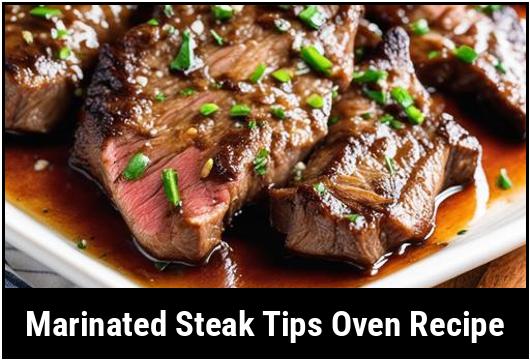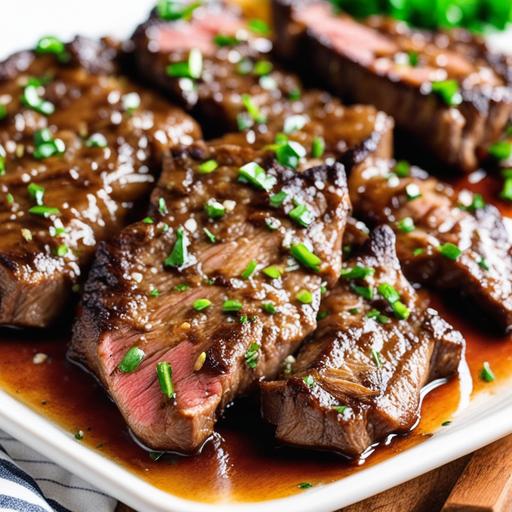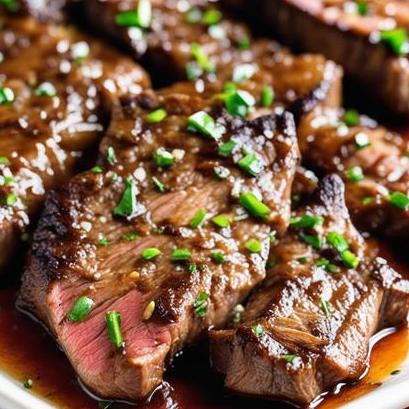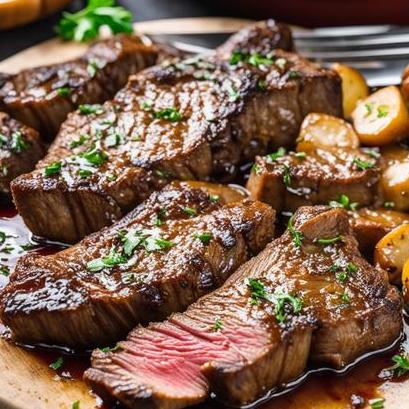
Marinated Steak Tips Oven Recipe: A Culinary Delight Worth Savoring
Steak is an epitome of indulgence; its succulent texture and robust flavors tantalize the taste buds like nothing else. While grilling is often the go-to method for cooking steak, the oven offers a convenient alternative that produces equally mouthwatering results. In this comprehensive article, we will delve into the art of marinating and cooking steak tips in the oven, exploring various aspects of food science, culinary details, selection, cleaning, preparation, tips, variations, doneness checks, and more. Get ready to embark on a flavorful journey!
The Science Behind the Perfect Steak
Before diving into the culinary aspects, let’s delve briefly into the food science behind a tender and juicy steak. Steaks, particularly those from tougher cuts like beef tips, benefit from marination – a process that tenderizes the meat and infuses it with flavors. Marinating helps break down connective tissues, enhancing tenderness while adding depth to the final dish.
Acidic ingredients, such as vinegar or citrus juices, are commonly used in marinades. They help to disrupt the protein structure in the meat, allowing it to retain moisture, absorb flavors, and maximize tenderness. Fats, such as olive oil, can also be added to the marinade to enhance the steak’s juiciness and prevent it from drying out during the cooking process.
Selecting the Perfect Steak Tips
When it comes to selecting steak tips for marinating and cooking in the oven, it is crucial to choose the right cut. Look for beef tips labelled as tender, such as sirloin or filet tips. These cuts are known for their tenderness and flavor, making them ideal candidates for this recipe.
Additionally, opt for cuts with marbling – streaks of fat running through the meat – as they contribute to both flavor and tenderness. The marbling provides moisture and richness during cooking, resulting in a melt-in-your-mouth texture that meat-lovers adore.
Cleaning the Steak Tips

Once you have selected the perfect steak tips, it’s vital to ensure they are properly cleaned before proceeding with marination. Rinse each piece thoroughly under cold water, removing any surface contaminants or bone fragments that might be present.
Pat the steak tips dry using paper towels, ensuring they are completely moisture-free. Drying the meat helps promote better browning during cooking and ensures the marinade adheres to the surface evenly.
Preparing the Marinade – The Flavor Infusion
The marinade plays a pivotal role in transforming ordinary steak tips into a symphony of flavors. While there are countless marinade variations, we will explore a classic and versatile option that never disappoints.
Classic Steak Tips Marinade – A Burst of Flavors
Ingredients:
-
¼ cup soy sauce
-
¼ cup olive oil
-
2 tablespoons Worcestershire sauce
-
2 tablespoons balsamic vinegar
-
4 cloves garlic, minced
-
1 tablespoon Dijon mustard
-
1 tablespoon honey
-
1 teaspoon dried rosemary
-
1 teaspoon dried thyme
-
Salt and pepper to taste
Instructions:
-
In a mixing bowl, combine the soy sauce, olive oil, Worcestershire sauce, balsamic vinegar, minced garlic, Dijon mustard, honey, dried rosemary, dried thyme, salt, and pepper. Whisk all the ingredients together until well blended.
-
Place the steak tips in a sealable plastic bag or a non-reactive dish. Pour the marinade over the meat, ensuring that it is fully submerged.
-
Seal the bag or cover the dish and refrigerate for at least 2 hours or, ideally, overnight. The longer the steak tips marinate, the more intense the flavors will become.
Mastering the Art of Marination

Marinating steak tips is a crucial step to unlock maximum flavor potential. Proper marination not only tenderizes the meat but also infuses it with the desired flavors. The keys to successful marination lie in technique, timing, and temperature.
The Technique: Ensuring Even Coverage
When marinating steak tips, you want to make sure the marinade thoroughly coats every surface of the meat. This is best achieved by placing the steak tips in a sealable plastic bag or using a non-reactive dish, ensuring the marinade engulfs the meat completely. Carefully massage the marinade into the meat and leave no area untouched. This technique guarantees an even distribution of flavor and tenderness.
The Timing: The Dance of Flavors
While marinating for a longer duration intensifies the flavors, it’s important not to exceed the recommended timeframe to prevent the meat from becoming overly tender. Marinating times can vary depending on personal preference, but a minimum of 2 hours is recommended. For a more robust taste, marinate overnight, allowing the flavors to penetrate deep into the meat fibers, resulting in a tantalizing experience.
The Temperature: The Chilled Mode
To ensure food safety, always marinate your steak tips in the refrigerator. The cold temperature inhibits bacterial growth, ensuring your marinated meat remains safe to consume. It is essential to give the meat enough time to marinate while maintaining proper refrigeration principles.
Preparing the Steak Tips for Cooking
Once the steak tips have marinated to perfection, it’s time to prepare them for their flavorful journey in the oven. Here’s how to ensure your steak tips come out tender, juicy, and packed with flavor.
-
Remove the steak tips from the marinade and allow any excess marinade to drip off. Discard the remaining used marinade.
-
Allow the meat to come to room temperature, ensuring even cooking throughout. This step is crucial as cold meat straight from the refrigerator may cook unevenly, resulting in less desirable texture and doneness.
Achieving the Perfect Doneness

Determining the steak’s doneness is an essential aspect of cooking any meat. Oven cooking provides a reliable method to achieve the desired doneness without compromising tenderness or flavor. Let’s explore some key temperature ranges and their corresponding steak doneness levels:
-
Rare: An internal temperature of 120°F to 125°F (49°C to 52°C) yields a bright red center and requires approximately 8-10 minutes of cooking time per inch of thickness.
-
Medium-rare: An internal temperature of 130°F to 135°F (54°C to 57°C) results in a rosy pink center and requires approximately 10-12 minutes of cooking time per inch of thickness.
-
Medium: An internal temperature of 140°F to 145°F (60°C to 63°C) creates a warm pink center and requires approximately 12-14 minutes of cooking time per inch of thickness.
-
Medium-well: An internal temperature of 150°F to 155°F (65°C to 68°C) produces a slightly pink center and requires approximately 14-16 minutes of cooking time per inch of thickness.
-
Well-done: An internal temperature of 160°F (71°C) and above creates a fully cooked steak without any pink and requires approximately 16-18 minutes of cooking time per inch of thickness.
Cooking the Marinated Steak Tips in the Oven
Now that our steak tips are ready and their desired doneness is defined, it’s time to unleash the magic of the oven. With proper cooking techniques, we can achieve a perfectly cooked steak bursting with flavor.
Ingredients:
-
Prepared marinated steak tips
-
Salt and freshly ground black pepper (to taste)
Instructions:
-
Preheat your oven to 400°F (200°C), ensuring it reaches the desired temperature before placing the steak tips inside.
-
While the oven preheats, season your marinated steak tips with salt and freshly ground black pepper according to your taste preferences. This step adds an additional layer of flavor to the finished dish.
-
Place the seasoned steak tips on a wire rack set over a baking sheet to ensure even heat distribution and to allow excess marinade to drip off during cooking. This technique prevents the steak tips from becoming soggy.
-
Slide the baking sheet with the steak tips into the preheated oven, positioning it in the center. Allow the steak tips to roast for the calculated time based on their desired doneness level, as mentioned earlier.
-
Halfway through the cooking time, gently flip the steak tips to ensure even browning and optimum tenderness on both sides.
-
Once the steak tips reach the desired internal temperature, remove them from the oven. Remember to account for residual heat, as the steak will continue to cook a bit after removal from the oven.
-
Allow the steak tips to rest for 5-10 minutes before slicing or serving. This rest period allows the juices to redistribute within the meat, enhancing the overall juiciness and tenderness.
Avoiding Overcooking and Undercooking

Achieving the perfect balance between doneness and tenderness is essential to a successful steak. However, it’s easy to fall victim to common pitfalls like overcooking or undercooking. Let’s explore tips and tricks to avoid these culinary perils.
Overcooking – The Enemy of Juiciness
Overcooking steak tips can result in dry, tough, and undesirably chewy meat. Follow these guidelines to ensure you never fall prey to the snares of overcooking:
-
Invest in a reliable meat thermometer to accurately monitor the internal temperature of the steak tips. This handy kitchen tool takes the guesswork out of doneness and allows you to cook the steak tips to perfection.
-
Regularly check the internal temperature of the steak tips during the cooking process. Monitoring the temperature will help you prevent overcooking, ensuring your steak tips are flawlessly tender and juicy.
Undercooking – A Recipe for Uneasiness
While some prefer their steaks to be cooked less, it’s essential to strike a balance between tenderness and bacterial safety. Avoid undercooking by following these fundamental guidelines:
-
Use a meat thermometer to verify that the steak tips reach the recommended minimum internal temperature for your desired level of doneness.
-
If you enjoy rare or medium-rare steak tips, ensure you source high-quality, fresh meat to minimize the potential risks of consuming undercooked beef.
Exploring Delicious Variations
For culinary enthusiasts, experimentation and personalization are key elements of the cooking journey. Although our classic marinated steak tips recipe is a delight on its own, it’s worth exploring a few delicious variations to satisfy your taste buds.
Spicy Cajun Steaks
Looking to add a fiery kick to your steak tips? Try this tantalizing variation inspired by Cajun flavors:
-
Enhance the marinade by adding 1 teaspoon of cayenne pepper, 1 teaspoon of paprika, ½ teaspoon of onion powder, and ½ teaspoon of thyme.
-
Allow the steak tips to marinate overnight for an intensified flavor experience.
-
Follow the cooking instructions mentioned earlier to achieve your desired level of doneness.
Teriyaki Glazed Delight
Give your steak tips an Asian twist with this teriyaki-inspired variation:
-
Adjust the marinade recipe by replacing the balsamic vinegar with 2 tablespoons of low-sodium soy sauce, 1 tablespoon of rice vinegar, and 1 tablespoon of brown sugar.
-
Add a touch of ginger powder and sesame oil to the marinade for an extra depth of flavor.
-
Allow the steak tips to marinate for a minimum of 4 hours or, preferably, overnight for an enhanced taste experience.
-
Proceed with the cooking instructions provided earlier, ensuring you achieve the desired doneness.
Elevating Your Culinary Creations
While marinated steak tips cooked in the oven are already a culinary delight, you can further enhance your creations by exploring various complementary flavors and suitable accompaniments. Consider pairing your succulent steak tips with a velvety garlic mashed potatoes, caramelized onions, or a vibrant seasonal vegetable medley.
Moreover, a garnish of freshly chopped herbs like parsley or cilantro can offer a burst of freshness to each bite. Finally, a drizzle of your favorite steak sauce or a velvety homemade Bearnaise sauce can elevate the overall flavor profile, providing a gratifying finishing touch.
Conclusion
Congratulations on venturing into the world of marinated steak tips cooked to perfection in the oven! We have covered a wide array of topics, ranging from food science and culinary details to selection, cleaning, preparation, tips, variations, doneness checks, recipe, and more.
By following the informative steps provided in this comprehensive article, you will be well on your way to creating tender, succulent, and flavorful marinated steak tips that will leave your guests in awe. So, roll up your sleeves, embark on this flavorful journey, and indulge in the heavenly joy that perfectly cooked steak tips offer. Bon appétit!
Sources
FAQS On Marinated Steak Tips Oven Recipe
How Long Should I Marinate The Steak Tips For In This Recipe?
It is recommended to marinate the steak tips for at least 2 hours, or preferably overnight, to allow the flavors to fully infuse into the meat.
Can I Use A Different Type Of Meat For This Recipe?
While this recipe is specifically for steak tips, you can certainly use a different type of meat such as chicken or pork if desired. Just be aware that the cooking times may vary.
What Temperature Should I Set The Oven To For Cooking The Steak Tips?
Preheat your oven to 375°F (190°C) for optimum cooking results.
Do I Need To Let The Steak Tips Rest Before Slicing?
Yes, it is best to let the steak tips rest for about 5-10 minutes after cooking to allow the juices to redistribute and the meat to become tender.
Can I Freeze The Marinated Steak Tips For Later Use?
Yes, you can freeze the marinated steak tips in an airtight container for up to 3 months. Just be sure to thaw them in the refrigerator before cooking.



